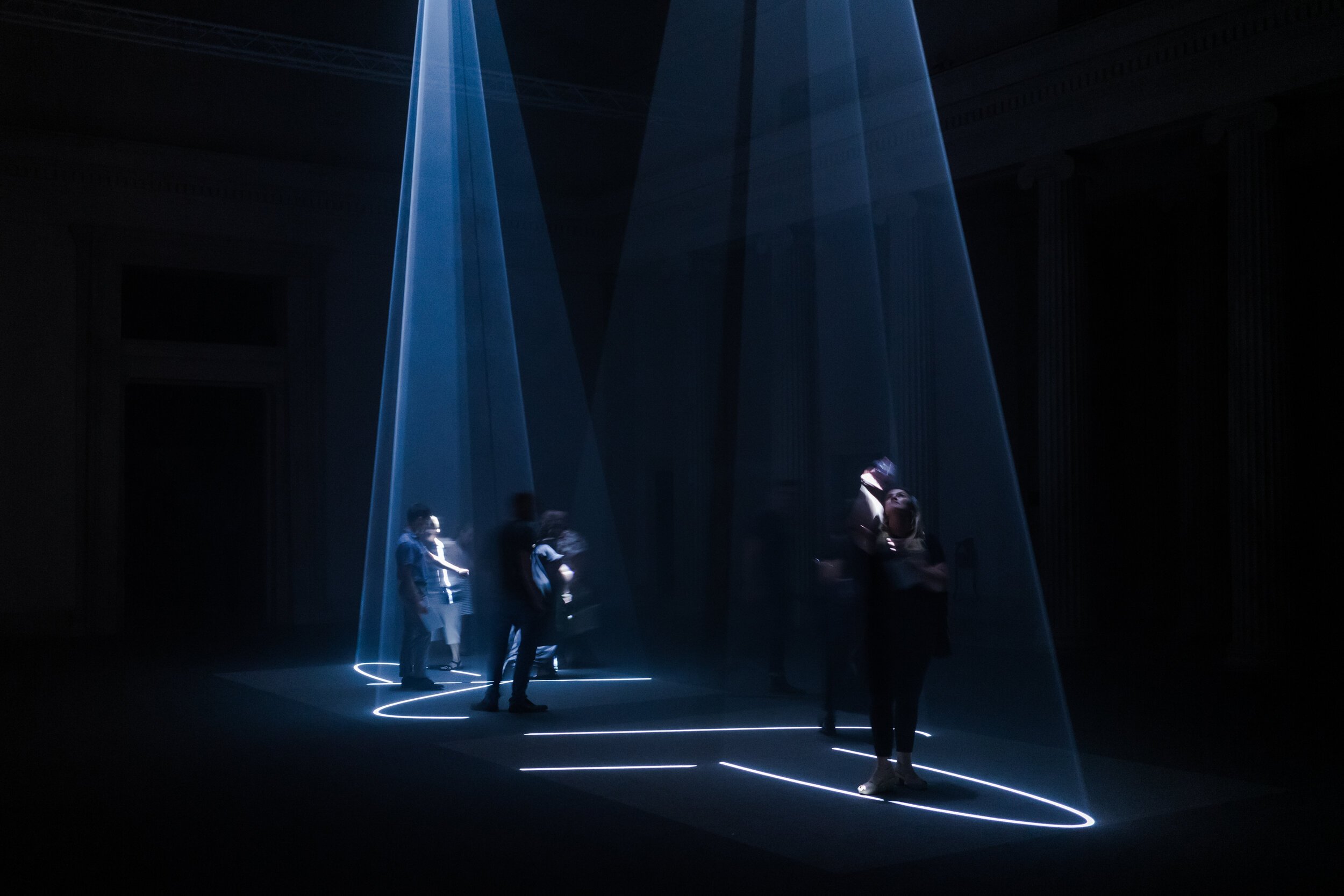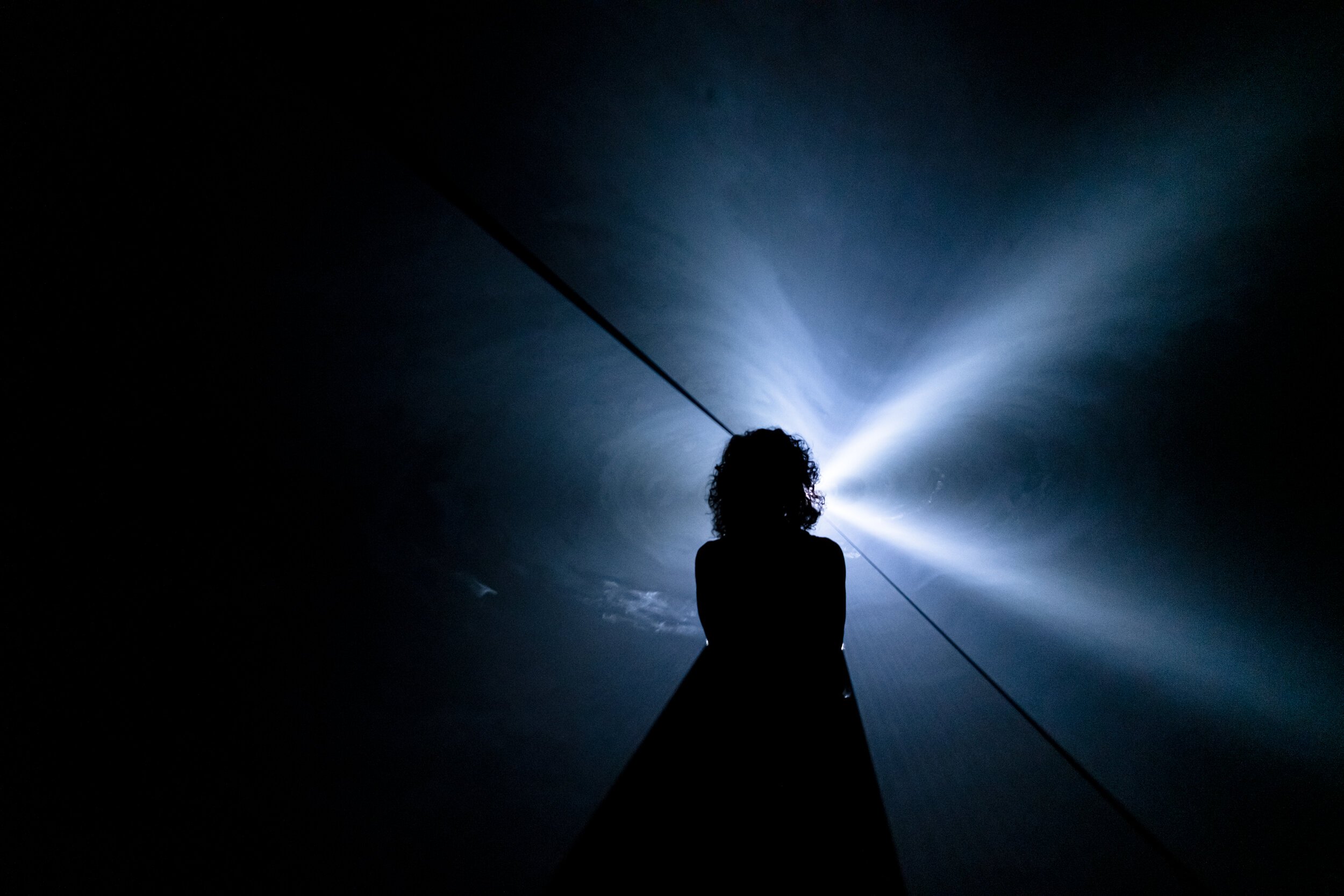Anthony McCall at the Albright Knox Art Gallery
by :
Tara Merenda Nelson
Anthony McCall, installation view, Between You and I at Albright-Knox Art Gallery. Photograph by Nando Alvarez-Perez.
In 1973 Anthony McCall left his native England and set sail for New York to join the city’s already well-established avant-garde film scene. In response to the minimalist currents in sculpture and painting, film artists of the 1960s and early 70s created works that dissected the essence of cinema by drawing attention to the experience of pure light reflected in time. Influential in this movement were Tony Conrad’s The Flicker (1966), consisting of alternating frames of black and white film that, when projected, produce a stroboscopic frenzy of pulsating light; Barbara Rubin’s radical multi-projector masterpiece, Christmas on Earth (1963); and Andy Warhol’s experiments with durational cinema in epics such as Sleep (1963) and Empire (1964), projects that confronted audiences with “real time” as represented through the unblinking eye of the motion picture camera.
It is from this milieu that McCall and his Line Describing a Cone (1973), the first of the artist’s “solid-light” series, emerge. In Line Describing a Cone, a thin white beam is projected and slowly forms a cone of light made visible (originally) by the cigarette smoke of New York’s studios and screening rooms. McCall continued to build on this exploration of atmosphere, light, and space in subsequent solid-light films until his withdrawal from the art world at the end of the 1970s. While McCall returned to artmaking and publicly showing both new and historic projects in the early 2000s, Dark Rooms, Solid Light at the Albright-Knox is his first solo museum exhibition in North America.
Upon entering the space, peeking behind a literal curtain, visitors are immediately confronted with a large screen on which an ellipse and a wave form slowly intersect. Move around the screen and the true nature of the work, Throes II (2011), is revealed: a three-dimensional version of the linear images seen on the screen. A haze machine gives substance to the forms in light as they curl and connect in the center of the room. Once inside the light, the experience transforms from passive to active, and what was once merely visible becomes palpable. Each movement causes a change in the mist and the projected form. Throes II satisfies whatever curiosity one may have had about Cone, enveloping the viewer in a sensory environment stimulated by breath and light. What also emerges here is the question of spectacle: Throes II reiterates discoveries made in previous work for the sake of showcasing their most seductively entertaining aspects.
Anthony McCall, installation view, Throes II at Albright-Knox Art Gallery. Photograph by Nando Alvarez-Perez.
There is a reverent hush in the cathedral-like Sculpture Court, which holds the exhibition’s largest work, Between You and I (2006). The vertical vastness of this space is accentuated by the depth of the darkness that fills it. Projected from the center of the ceiling, two points of light spread out into shifting cones, terminating in curving lines on the floor. These tents of light draw viewers into their misty enclosures, from which they may cast their eyes up to see distant punctures in the darkness or bow their heads to follow the shifting white strands underfoot. Whatever shapes the lines take are inconsequential, as the energy of the experience radiates from the light itself, its presence a permeable boundary of substance without solidity. The large space in which this work is installed allows viewers to seek out new vantage points and find different perspectives on the piece. There is no mystery here, each element of the installation is openly revealed. Any illusion that transpires takes place within the viewer's own experience, sounding from the depths of a perceptual reality only they can comprehend. Of all the works in this exhibition, Between You and I most impactfully underscores the essence of McCall’s work: being present.
The remaining three solid light works in the show–You and I, Horizontal (2005), Doubling Back (2003), and Split Second (Mirror) (2018)–engage with different concepts through the same formal elements of projected light, air, and motion. You and I, Horizontal plays with the cinematic wipe as method of transition between an ellipse, a line, and a wave; Doubling Back models sine waves traveling in vertical and horizontal space simultaneously; and Split Second (Mirror) uses a mirror to create two cones that interrupt and reverse each other. While stimulating, their presentation en masse reduces the works’ impact and emphasizes their entertainment value.
Two brightly lit rooms with McCall’s works on paper give viewers a chance to engage more deeply with the artist’s process. Here are notes and sketches that illuminate McCall’s inquiry into the essence of line and light and the progress of his solid-light series over time. These spaces provide a more expansive view of McCall’s oeuvre and heighten the intellectual engagement between the artist and his audience.
Dark Rooms, Solid Light provides what its name promises, and experiencing these works is worthwhile for anyone seeking a visceral encounter with art. While the works at times border on repetitive, their impact is undeniable, and the experience of solid light lingers long after the spectacle fades.
Anthony McCall, installation view, Between You and I at Albright-Knox Art Gallery. Photograph by Nando Alvarez-Perez.
Tara Merenda Nelson is the Curator of Moving Image Collections at Visual Studies Workshop in Rochester NY.
Albright Knox Art Galleries
1285 Elmwood Ave, Buffalo, NY 14222




